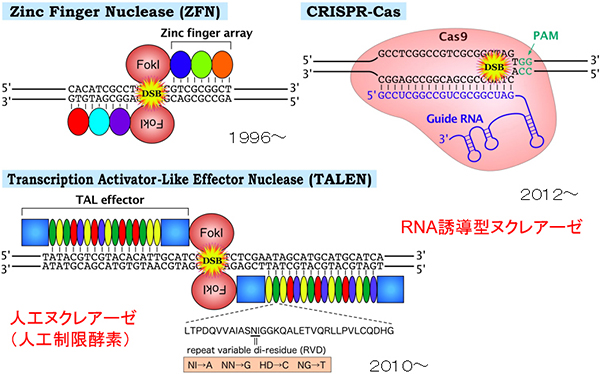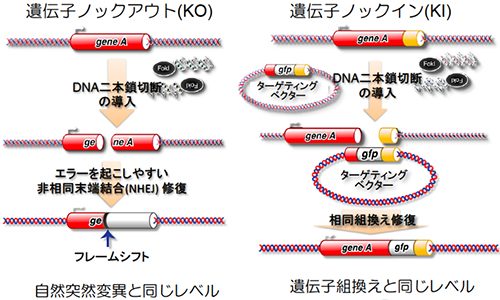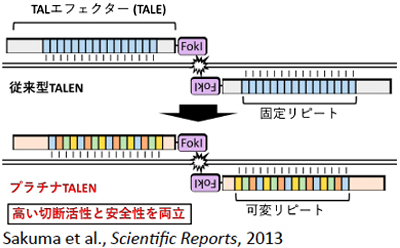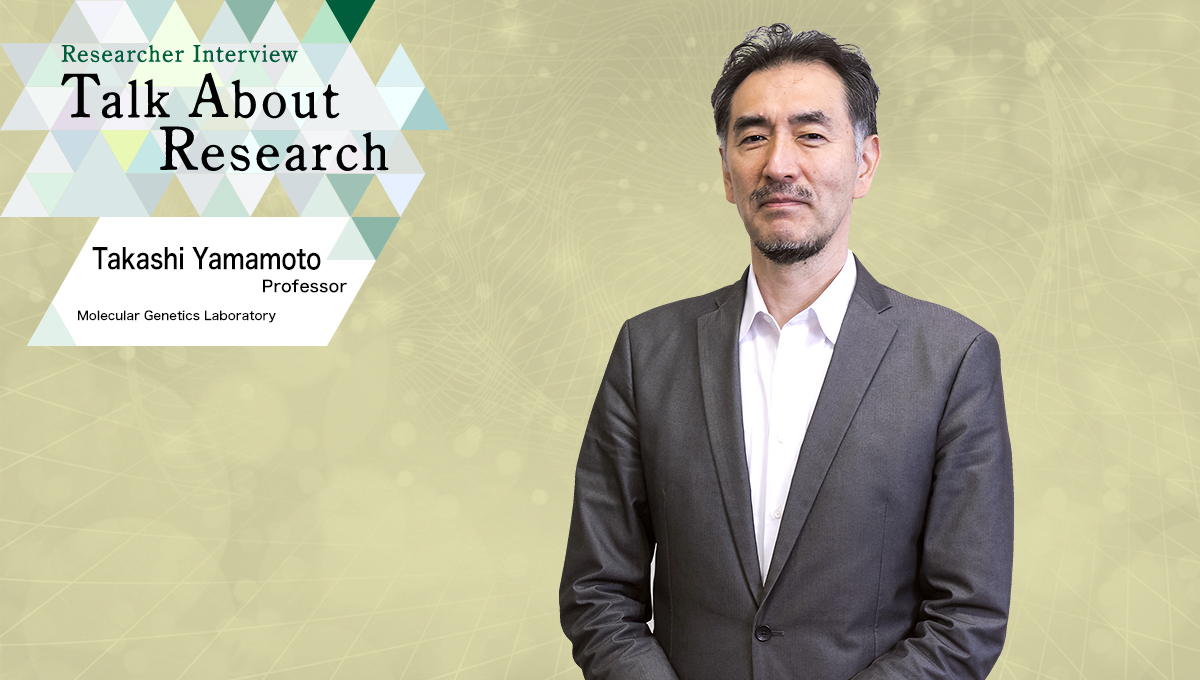Being the first to introduce genome editing technology in Japan,
Prof. Yamamoto has become someone who greatly drives domestic research
In October 2020, the news that the Nobel Prize in Chemistry was awarded to Dr. Emanuelle Charpentier and Dr. Jennifer Doudna, who developed CRISPR-Cas9, the third-generation of genome editing technology, made headlines around the world. Genome editing has become a more common technology that is available to many scientists, and its prospects keep growing. In December of the same year, genome-edited food that was produced in Japan was approved domestically for the first time. Application of genome-editing technology is not only limited to selective breeding in the agricultural, livestock, and fishery field, but is also utilized in a wide variety of fields such as biofuel development, drug discovery, gene therapy, and the development of disease experimental models for cells and animals, and industry-academia-government joint research projects have therefore been conducted all over the world.
In Japan, Hiroshima University has been the center of genome editing technology research, and Prof. Takashi Yamamoto of the Molecular Genetics Laboratory is the leading researcher in this field. In the genome editing technology publication ranking in the October 2019 issue of Nature Biotechnology, the US science journal, Prof. Yamamoto was ranked second in the world, while Dr. Sakuma, an associate professor from the same laboratory, was ranked fifth. This proves their world-class reputation.

Genome editing is the technology to modify genes by utilizing the repair process of the disconnected DNA. An artificial DNA cutter enzyme, or genome editing tool, forms the basis of this technology, and the history of developing this enzyme is the history of genome editing technology development.
According to Prof. Yamamoto, an artificial DNA cutter enzyme that works like scissors is a fundamental technology similar to a computer operating system. The first and second generations, Zinc Finger Nuclease (ZFN) and TALEN, were developed in 1996 and 2010, respectively, before the development of CRISPR-Cas9.
“In gene editing, an enzyme that precisely cuts DNA is utilized first, but it was difficult to produce a scissor-enzyme that cut only a specific gene. Our laboratory could also make ZFN, but it was very difficult to cut the intended site. Then TALEN, the second-generation enzyme, was released, and we improved TALEN to make Platinum TALEN with a better cutting capability, which we still use. Then the third generation, CRISPR-Cas9, is much more convenient to use, and more efficient. It has rapidly become popular in fundamental research fields because of the low cost. We are also improving CRISPR-Cas9 to make a better tool.
 Fig. 1: Three types of artificial DNA cutter enzymes are utilized for genome editing.
Fig. 1: Three types of artificial DNA cutter enzymes are utilized for genome editing.
Although this field had not shown much progress in Japan, Prof. Yamamoto’s laboratory introduced genome editing technology at a very early stage. Furthermore, while other research groups introduced this technology by purchasing it from private companies, he established the ZFN manufacturing system in 2008 and published the first research paper in 2010. What he had been tackling was the genome editing of sea urchin embryos.
“My first expertise was developmental biology and I researched sea urchins. Through this research, I wanted to see the activity of genes through light intensity. Such quantitative light analysis technology is part of a physicist’s expertise. At that time, I belonged to the Department of Mathematical and Life sciences, Graduate School of Science, Hiroshima University, and I was surrounded by researchers in mathematics, chemistry, and physics. So, I thought that we could develop some collaborative projects. I speculated that if we could make the genes glow when they are activated in an urchin embryo, then grasp the light intensity of living sea urchins under a microscope, the function of a certain gene may be revealed. I expected that this method could clarify which gene works in which way throughout the formation process of urchins from a living egg, and genome editing was essential for proceeding with such interdisciplinary research. The first trigger was my motivation to add a glowing gene to a target site,” Prof. Yamamoto said. In 2008, his laboratory was able to insert a fluorescent gene by cutting a target gene utilizing ZFN and monitored the expression of the gene that forms a bone in the early embryos of sea urchins.
 Fig. 2: Genome editing technology based on an artificial DNA cutter enzyme.
Fig. 2: Genome editing technology based on an artificial DNA cutter enzyme.
Developing many unique genome editing technologies
in a laboratory full of Hiroshima University alumni
Since then, his research group continued the research on sea urchins, while also researching genome editing technology itself, and succeeded in developing various unique technologies. The published research results are mainly as follows. (The following describes only some of the research. The date in parentheses shows the release date.)
- Development of Platinum TALEN, a highly efficient genome editing tool, and its production system (November 2013)
- Development of the PITCh method, a simple gene insertion method by genome editing technology (December 2015)
- Development of the LoAD system, a new technology to increase the probability of obtaining the expected modification by improving genome editing technology (August 2018)
- Development of the TREE system that applies genome editing technology and highly activates genes (October 2018)
■PITCh method
A new gene knock-in method that utilizes TALEN, CRISPR-Cas9, and MMEJ (microhomology-mediated end-joining) repair pathways. Compared to the previously common method which relies on homologous recombination, this can be applied to types of cells or creatures with low homologous recombination activity and it has gained a good reputation as a simple and highly efficient method that widens the applicable scope of genome editing technology.
■LoAD system
A protein called Cas9 forms a complex with sgRNA (Single-guide RNA), modifies CRISPR-Cas9, which recognizes and cuts the target DNA sequence, and greatly improves the knock-in efficiency of inserting a target gene to the genome’s target site. It enabled knock-in for the different fluorescent reporter genes to the three different gene loci at the same time. This was a world-first announcement of a CRISPR-Cas9 modification research result that accomplished the introduction of multiple gene knock-in without selection pressure.
■TREE system
This system modifies CRISPR-Cas9 and inactivates cutter activity without losing DNA recognition activity. It highly accumulates activated protein around the target gene without cutting or rewriting the DNA sequence and obtains higher activation than preexisting technologies. It achieved 30 times the enhancement of the activity of the cancer-suppressing gene than that of the previous method in a pancreatic cancer cell. Application to highly safe cancer treatment is expected.

The open innovation format of genome editing technology has already been established all over the world, and anyone can freely utilize it for basic research. The technology developed by Prof. Yamamoto's research group has been provided all over the world by Addgene, a U.S. non-profit corporation, and this has led to Prof. Yamamoto and Dr. Sakuma, an associate professor, being jointly awarded a Blue Flame Award in 2016. Prof. Yamamoto's contribution to spreading genome editing technology is also highly regarded.
His research has two major characteristics. One is constantly intervening in the fundamental process of genome editing and aiming at the development and establishment of new technology, and the other is establishing an extensive research system. As of fall 2020, more than 100 joint research projects were in progress simultaneously, and needless to say, two associate professors in addition to senior lecturers support Prof. Yamamoto and devote themselves to the smooth progress of the collaborative research.
"It is impossible to handle everything in our laboratory, so we currently provide basic research projects for people with the necessary skills and operate them as joint research projects. Credit for our great record of achievement is owed to many staff including associate professor Sakuma. I’m proud that all of them, including myself, are alumni of Hiroshima University,” he said with a broad smile.
 Fig. 3: Platinum TALEN, the TALEN technology developed by Hiroshima University.
Fig. 3: Platinum TALEN, the TALEN technology developed by Hiroshima University.Platinum TALEN, developed by Hiroshima University, has quite high cutting activity. It is utilized for gene knockout for many creatures.
Devotion to research, development, and social implementation
in consideration of future trends.
Hiroshima will be the place to release state-of-the-art technologies
Concurrent with this research and development, he is focusing on the "social implementation" of genome editing technology.
“The development of genome editing technology in Japan is far behind that of other countries. It is almost two laps behind, and I am always thinking of how to catch up with the others. To achieve that, we have to cooperate with industry and conduct an all-Japan research scheme,” he said. Based on this idea, various collaborative projects and organizations will be established.
The first achievement utilizing this idea was the establishment of the Genome Editing Consortium (2012). This is a community organized on the request of many researchers who had learned the potential of genome editing technology for various fundamental research and wanted to apply that to their experimental animals.
In addition, he established the Japanese Society for Genome Editing in 2016.
“From now on, we cannot win in either academic research or other development fields pursued by the private companies without using genome editing technologies. I’d like to make them available for industry, and prepare a place to provide information for various companies. Based on this intention, I established the Japanese Society for Genome Editing, an organization to promote the social implementation of genome editing technology.”
Around the same time, a research field called Creation of the Production Technology of Innovative Useful Cells and Creatures by Genome Editing was adopted as a Program of Open Innovation Platform with Enterprises, Research institute and Academia (OPERA) by JST (the Japan Science and Technology Agency). This is a program to form an enterprise-academia co-creation platform with the Genome Editing Research Base of Hiroshima University, which was established in 2014 as its core, and to establish a foundation for social implementation of genome editing technology that is expected to produce innovative value creation in fields such as bioindustry and life science. Currently, 11 research institutes and 23 enterprises jointly conduct various development and research projects (in the six years since fiscal year 2016).
 Fig. 4: Program of Open Innovation Platform with Enterprises, Research institutes, and Academia.
Fig. 4: Program of Open Innovation Platform with Enterprises, Research institutes, and Academia.
And in February 2019, the Genome Editing Innovation Center, Hiroshima University was established at Innovation Plaza, Hiroshima University as a joint project base of industry, research institutes, and academia.
The surprising thing is that all the above organizations are managed by Prof. Yamamoto. He has such vitality! Furthermore, in August 2019, PtBio Inc., a start-up company that sells cells and animals produced by Platinum TALEN was established to respond to the needs of joint research. This company provides the best genome editing technologies for industrial application while providing consulting for the safety evaluation necessary for social implementation and strategies for intellectual property, and the training of bio- and digital experts.
Prof. Yamamoto continues his activities, such as conducting research projects and organizing other undertakings with the various organizations and people involved. What is the source of his motivation?
He says that the joy of discovery and creation, the intention of social contribution, and the abovementioned desire for catching up with other countries and training young people are the source of his motivation.
“It is especially necessary for this era to establish schemes for actively promoting new research while showing concrete ideas such as what kind of research leads to the solving of a certain problem to young researchers, and stimulate their motivation,” he said.
 Fig. 5: Summary of the establishment of the Genome Editing Innovation Center, Hiroshima University, and its sustainable projects.
Fig. 5: Summary of the establishment of the Genome Editing Innovation Center, Hiroshima University, and its sustainable projects.
He also said with a sense of mission, “The only drawback of CRISPR-Cas9 is its very high patent royalty. It costs 10 billion yen as a single sum for pharmaceutical use. Since it’s too expensive to use, we are considering ways to apply a domestic tool based on ZFN or TALEN for commercial use while using CRISPR-Cas9 for fundamental research. I also want to support commercial use by enterprises and establish a support base that is useful for the people starting business in these fields or local revitalization. I think those are the things I have to accomplish within the 10 years until I retire.”
Genome editing technology still has many challenges in terms of its safety and ethical aspects. How will this progress in the future? “It will become an essential technology," Prof. Yamamoto said with absolute certainty. He expects that various human issues such as food problems can be solved by applying iPS cells or AI, and the development of artificial life could be possible in the future.
"Because the scale of research budgets in Japan tends to be much smaller than that overseas, we can't win at all in terms of development speed. But we still have some chances. I have a big dream. I'd like to start a new bioscience technology development project from Hiroshima in the future.”
 Opened on August 3, 2022
Opened on August 3, 2022


